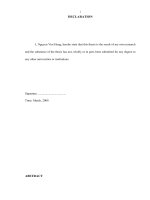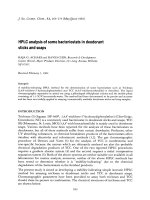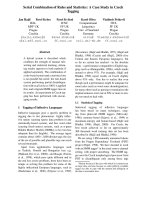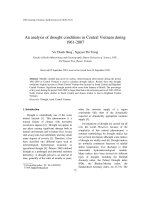Analysis of sanitation conditions in Colombia - Case study: Atlantico department
Bạn đang xem bản rút gọn của tài liệu. Xem và tải ngay bản đầy đủ của tài liệu tại đây (290.4 KB, 6 trang )
International Journal of Mechanical Engineering and Technology (IJMET)
Volume 10, Issue 12, December 2019, pp. 241-246, Article ID: IJMET_10_12_026
Available online at />ISSN Print: 0976-6340 and ISSN Online: 0976-6359
© IAEME Publication
ANALYSIS OF SANITATION CONDITIONS IN
COLOMBIA. CASE STUDY: ATLANTICO
DEPARTMENT
Rodríguez Miranda, Juan Pablo
Profesor Titular. Facultad del Medio Ambiente y Recursos Naturales.
Universidad Distrital Francisco José de Caldas.
Espinosa Romero, Ana Patricia
Directora Programa de Ingeniería Ambiental. Facultad de Ingeniería.
Universidad de La Guajira
Salcedo Parra, Octavio
Profesor Titular. Facultad de Ingeniería. Universidad Distrital Francisco José de Caldas.
Profesor de Planta, Departamento de Ingeniería de Sistemas e Industrial, Universidad
Nacional de Colombia, Sede Bogotá.
ABSTRACT
This manuscript exposes the considerations and analysis elements of sanitation
and drinking water in Colombia (South America) in terms of some indicators,
investments and realities, with the purpose of establishing the gaps and analyzing the
possible solutions and alternatives to reach the universal goals of toppings.
Keywords: Sanitation, sewage, drinking water, water resources
Cite this Article: Rodríguez Miranda, Juan Pablo, Espinosa Romero, Ana Patricia,
Salcedo Parra, Octavio, Analysis of Sanitation Conditions in Colombia. Case Study:
Atlantico Department. International Journal of Mechanical Engineering and
Technology 10(12), 2019, pp. 241-246.
/>
1. INTRODUCTION
The availability of the water resource, is dependent on the supply and demand of the same,
understand the supply of water as, the amount offered or amount of water available naturally
(essential input), according to the influence of the hydrological cycle of the area of study, and
the demand for water, as the quantity demanded due to the different anthropic and natural
activities in the study area, and especially in a river basin. Given the above, there may be a
balance in the water balance, that is, a situation where water supply and demand are equal or
approximately equal; in others there may be a surplus of water, the supply of water is higher
than the demand, and in addition, there may also be a water deficit, that is the demand for
water exceeds its supply. According to an IPCC report (IPCC., 2008) a basin is considered to
have water stress when its water availability per inhabitant is less than 1000 m3/year or when
/>
241
Rodríguez Miranda, Juan Pablo, Espinosa Romero, Ana Patricia, Salcedo Parra, Octavio
the ratio between water withdrawal and the annual average runoff is greater than 0.4. The
same study considers that a volume of water greater than 1000 m3 per inhabitant per year is
sufficient for domestic, industrial and agricultural uses.
According to IDEAM data (IDEAM, 2004; IDEAM, 2014) , in Colombia there is a water
yield of 56 L/s km2 (it is above the world average, 10 L/s km2 and the Latin American
average,21 L/s km2); an annual volume of surface runoff 2012 km3 (equivalent to an average
flow of 63789 m3/s); the total per capita of surface runoff is 57000 m3/year and a total volume
of precipitation of 3267 m3 equivalent to 2864 mm/year, which means that 62% of the
precipitation becomes runoff; the environmental natural stored supply is 38 km3 but it is not
distributed homogeneously in the regions of the country; Therefore, there is a heterogeneous
distribution of water supply and demand, given the elements of water yields in each area.
According to IDEAM (IDEAM, 2014) , the water supply in the municipal headwaters is 7.5%
through underground water, 4.4% through reservoir, 1.3% through block water, 3.5% through
ground and surface water mixing, and 83.3 % by surface water (rivers, streams, pipes, springs
or reservoirs). Regarding the demand for water in Colombia (IDEAM, 2014), it states that: for
agricultural activities 46.6%, energy activities 21.5%, livestock activities 8.5%, domestic
activities 8.2%, industrial activity 5.9%, aquaculture activities 4.6%, mining activity 1.8%,
hydrocarbon activity 1.6% and service activity 1.3%.
According to figures from the Housing, City and Territory Ministry of (HCTM) of
Colombia for the drinking water and basic sanitation sector, for 2017, the total aqueduct
coverage (urban 97.8% and rural 73.2%) was 92.4%, sewerage total (urban 91% and rural
70%) of 88.0%; 52 % of municipalities in Colombia are without risk in the quality of drinking
water and 48% have at least low risk for drinking water consumption; the continuity of the
drinking water service on average is 20 hours per day in 62% of the municipalities and in the
remaining 38%, there is a continuity between 10 to 20 hours per day.
2. DEVELOPING
2.1. Sanitation in Colombia
According to (IDEAM, 2014), the biodegradable organic load (BOD5 ) discharged to water
systems after treatment in Colombia was 756945 Tons per year equivalent to 2102 tons per
day; for the chemical oxygen demand (COD) it was 1675616 tons per year equivalent to 4654
tons per day; for total suspended solids (TSS) it was 1135726 tons per year equivalent to 3154
tons per day; for total nitrogen (TN) of 126345 tons per year equivalent to 350 tons per day;
for total phosphorus (TP) it was 31915 tons per year equivalent to 88 tons per day; the largest
contributor is the domestic sector with 69% (61% for COD, 91% for TSS, 84% for TN, 92%
for TP), then the industrial sector with 28% (37% for COD, 7% for TSS, 16% for TN, 7% for
TP)) and then the coffee maker with 3% (2% for COD, 1% for TSS). The load removed by
wastewater treatment by the domestic and industrial sector for BOD is 32.1%, for COD of
31.6%, for TSS of 26.3%, for TN of 2.0% and for TP is 1.7%.
The National policy for the integral management of water resources (MAVDT, 2010),
established that in terms of the water supply, the ecosystems and hydro biological processes
on which the country's water supply depends must be conserved; for the demand for water,
the demand for water in the country must be characterized, quantified and optimized,
according to the activities and quality is added, where the objective is to improve the quality
and minimize the contamination of the water resource. Therefore, it is important to establish
that the inputs that must be taken into account for an adequate analysis and planning of the
basins, may have aspects of uses and criteria of surface water quality, norm of discharges for
surface waters, identification of users in the basin and the adequate analysis of the
environmental impacts associated with the activities generated in the basin, because this
/>
242
Analysis of Sanitation Conditions in Colombia. Case Study: Atlantico Department
affectation limits and restricts the use of the water resource, but does not contemplate the
environmental aspects and their valuation, in terms of the WWTPs with respect to the water
basins. In the BID document (BID, 2004) , Millennium Development Goals in Latin America,
a Universal goal was established, halving the percentage of people who lack access to
drinking water and basic sanitation, which leads to high investments in each country to reach
that goal. According to the Andean Development Corporation (ADC), in the Latin American
infrastructure management study (ADC, 2009), it established that households in Latin
America with access to water on the property is 87%, with access to public sewerage is 58%
and toilet connected to a sewer or septic tank is 66% and also complements that Colombia has
10% to 19.9% of the population with an inadequate system of disposal excreta. In the basic
indicators report, of the Pan American Health Organization (PAHO, 2012) , for Latin
America, 80% of the population has access to an adequate water supply, 54% of the
population has access to an adequate sanitation system; Our country has 92% of the total
population with access to drinking water sources (99% in the urban area and 72% in the rural
area) and 77% of the total population with access to sanitation facilities (82% in the urban
area and 63% in the rural area). Other indicators establish that the coverage (urban and rural)
of water supply is 91% and basic sanitation of 85% (Sánchez DeG, 2013; Castro, 2014). The
coverage of the aqueduct is 81.26% and the sewer system is 66.08% for the Department of
Cundinamarca, (Marín L, 2011). However, in an analysis of the sector, it is established that
our country (water coverage 88%) that in the 90s was above the average (average 85%) of
Latin America and the Caribbean in terms of coverage of water, in the years 2000 to 2010, it
was below the average (average 93%) of Latin America and the Caribbean in terms of water
coverage and in recent years 2011 to 2013, it is above the Latin American and the Caribbean
average (ACODAL, 2013) .
The National Plan for the management of municipal wastewater in Colombia (MAVDT,
2004), mentions that 237 MWWTP (21.7% of the municipalities of the country) have been
built in the country, generating 67 m3/s and 10% of them, the 10% presents a proper
functioning and the rest of the WWTPs are not aware of the real state of functioning and
operation and also, it is established that they do not treat all the wastewater produced by the
aforementioned municipalities. An increase in the flow of wastewater of 75.95 m3/s has been
observed in 2010, but only 18.93 m3/s equivalent to 24.92% of the wastewater generated in
454 built WWTPs is treated (MAVDT, 2010) . The most used technologies in the MWWTS,
are aerobic and anaerobic lagoons (55%), activated sludge (22%), percolating filters (14%),
anaerobic up flow reactor (9%); however, the status of the MWWTP built (454), 24% (108)
has a good state, 27% (122) in a regular state, 22% (100) in a poor state and 27% (124) is
unknown. state (MAVDT, 2010) . In the study (MAVDT, 2004) it is mentioned that there
must be an interrelation between the MWWTP, the sewage system and the receiving body,
where the concepts of integral management of the water resource are taken into account;
pressure on the resource, preservation of basins and potential uses of the source, but the
environmental assessment of the WWTPs with respect to water basins is not established.
Additionally, it can be mentioned according to the World Bank that the per capita cost for
wastewater treatment is US $ 100 (Marín L, 2011).
However, in the technical report on wastewater treatment systems in Colombia - baseline
2010 (Marín, 2012) , it states that of the 1119 Colombian municipalities, 490 have WWTP
(43.80%) and of these, they are a total of 556 WWTP in Colombia, where the largest number
of WWTP are in the Cundinamarca and Antioquia Departments. The installed capacity of the
WWTP was 33.2 m3/s, and as conclusion of the report it states: lack of monitoring and control
of the processes; water characterizations are not carried out, control of the input and output
flow is not carried out and the design flows are not known in such a way that the operation of
the systems is carried out empirically, autonomously and routinely; lack of knowledge of the
/>
243
Rodríguez Miranda, Juan Pablo, Espinosa Romero, Ana Patricia, Salcedo Parra, Octavio
operated systems, this does not allow to clearly plan the expansion and optimization of the
treatment systems; lack of corrective and preventive maintenance of wastewater treatment
systems; absence of vector control and sludge management programs; control over nonresidential wastewater discharges and monitor compliance with existing regulations. In
addition to the above, according to the analysis of the Colombian Association of Sanitary and
Environmental Engineering (ACODAL, 2013) , it states that 31% of cities in Colombia have
WWTP (primary treatment 29% and 1% tertiary treatment); where there has been an incorrect
selection of technologies, high investment and operation costs (although the investment
destined to the treatment of wastewater does not reach 1% of the amount invested or destined
in drinking water) and a poor protection of water sources, which puts environmental
sustainability at risk, due to the contamination of water resources, given the obsolete premise
being used, that the water resource in Colombia is infinite.
2.2. Some Solutions in Regional Planning
On the other hand, management strategies are focused on the regional planning of the water
resource, the optimization of the wastewater treatment plants built and the promotion of new
treatment alternatives, and the reuse of the wastewater as well as review, update and
regulatory development for the adjustment of policy instruments, but the environmental
assessment of the WWTPs in relation to water basins is not mentioned. However, conserving
the water basin through the more efficient allocation of the resource and also assessing the
effects resulting from development works and pollution on the water resource in particular
and in the general environment (García LE, 1998), but it was done essential reference to what
is politically viable and technically desirable, but without the explicit environmental
assessment of the WWTP on the water basin.
2.3. Case study. Department of the Atlantic, Colombia
Within the three sub-regions covered by the dike channel, one of the most affected regions
has been “The High Sub-region” in which damages accumulate - according to the Atlantic
Governorate , December 2010 - in municipalities such as Manatí and Campo de la Cruz del
100%, Candelaria 60%, Santa Lucia and Repelón 40%, Suán 10% and in the Sabanalarga
corregimientos (pablo and aguada de pablo) of 3%, this being equivalent to saying that there
is an affectation of 13000 homes and 185,000 people affected.
But before the flood of this part of the Atlantic department, it had an unsatisfied basic
needs index (IBN) of 24.7% according to DANE 2005 and the coverage of the aqueduct
service 90% urban (50% rural), of the service of sewage system of 50% urban (38% rural) and
cleaning service 80% urban according to the MAVDT 2010, and the picture was sad and
bleak in terms of drinking water and basic sanitation, although with valuable efforts of former
departmental governments, but still being insufficient to maintain a water security considered as the use of the productive capacity of the water, reduction of the destructive
force, eradication of poverty, better education and increase of the standard of living - in the
populations of the department, which leads to that problems of water diseases arise due to
population growth, low coverage of aqueduct services, sewerage and cleanliness, and the
rapid urbanization with a high share of overcrowding, along with diarrhea and cholera among
other diseases, which are some of the causes of infant death due to the intake of contaminated
water, which generate subsequent effects as a delay in growth and malnutrition.
Therefore, with the adequate and total access of the population to drinking water and basic
sanitation services, social and economic development of human settlements is obtained. But
returning to the situation that arises in the south of the department and seeing the drinking
water and basic sanitation systems of the aforementioned municipalities, totally under the
/>
244
Analysis of Sanitation Conditions in Colombia. Case Study: Atlantico Department
waters of the Magdalena River, only leads to reflect and act before the opportunity to build
new scenarios to have a better quality of life, which lead to having to manage and develop
elements of drinking water and basic sanitation, in a sustainable and balanced way, taking into
account social, economic and environmental interests, in order to provide a service that of
well-being to the population, decrease levels of morbidity and mortality due to water diseases,
decrease the infant mortality rate, increase life expectancy by improving the health and
hygiene of the population, reduce poverty, increase labor productivity and reduce social
spending for diseases and poverty assistance, among others.
This situation experienced due to the flood catastrophe, is an investment opportunity in
the drinking water and basic sanitation systems in this region of the department, to increase
the coverage of the aforementioned services and offer a better quality of life to people that
today are in a social, economic and environmental situation of disadvantage. This opportunity
indicates investments - based on the single window quality management system document,
project eligibility and feasibility, MAVDT and the reference values of the Development
Ministry and World Bank study (cost per inhabitant) - approximate according to conservative
USD calculations $ 104,895,000 distributed in drinking water supply system (aqueducts) of
51.31%, collection and treatment of sewage (sewage) of 47.18% and cleaning system (solid
waste) of 1.5%, which would indicate that according to what it establishes WHO (2004)
“improving the water supply reduces morbidity from diarrhea by 6% to 21%; improving
sanitation reduces diarrhea morbidity by 32%, hygiene measures, including education on the
subject. ” It is the time to act and be decisive in the human and economic development of the
department.
3. CONCLUSIONS
In terms of environmental or basic sanitation, it is observed that more state efforts are needed
to comply with the universality of the public water and sewage service, without neglecting the
fulfillment of sustainable development objectives, especially with ODS No. 6, clean water and
sanitation, to establish sanitary facilities to guarantee universal access to drinking water and
basic sanitation. The implementation of a precise environmental policy, to advance in a true
integrated management of water resources, which leads to decontamination plans of water
bodies, departmental water plans to guarantee coverage of aqueducts and sewers,
environmental recovery of water bodies and appropriations of water investment resources for
the improvement of existing infrastructure and construction of new ones are necessary in
Latin American countries.
THANKS
The authors are grateful that the secondary information obtained for the preparation of this
manuscript was with official figures from IDEAM, MVCT, MADS and environmental
authorities in Colombia (South America).
REFERENCES
[1]
[2]
[3]
ACODAL. (2013). Agua potable y saneamiento: Colombia se rezaga en el contexto
Latinoamericano, pasa de ocupar el 7 puesto en coberturas al 13. Bogotá: Asociación
Colombiana de Ingeniería Sanitaria y Ambiental.
ACODAL. (2013). Aguas residuales y ciudades. Bogotá: Asociación Colombiana de
Ingeniería Sanitaria y Ambiental.
Ashrafi, O. e. (2013). Greenhouse gas emission by wastewater treatment plants of the pulp
and paper industrty - modelling and simulation. International journal of greenhouse gas
control, 462 - 472.
/>
245
Rodríguez Miranda, Juan Pablo, Espinosa Romero, Ana Patricia, Salcedo Parra, Octavio
[4]
[5]
[6]
[7]
[8]
[9]
[10]
[11]
[12]
[13]
[14]
[15]
[16]
[17]
[18]
[19]
[20]
[21]
[22]
[23]
[24]
[25]
BID. (2004). Los objetivos de desarrollo del milenio en america latina y el caribe. Retos,
acciones y compromisos. Washington D.C.: Banco Interamericano de Desarrollo.
CAF. (2009). Caminos para el futuro. Gestión de la infraestructura en América Latina.
Caracas, Venezuela: Corporación andina de fomento (CAF).
Castro, H. (2014). Análisis y perspectivas de las coberturas de acueducto y alcantarillado
en el Departamento del Meta. Revista Orinoquia, 122-129.
Concetta M., e. a. (2011). Perfomance of sequential anaerobic/aerobic digestion applied to
municipal sewage sludge. Journal of environmental management, 1867 - 1873.
Flores X., e. a. (2014). Balancing effluent quality, economic cost and greenhouse gas
emissions during the evaluation of (plant - wide) control/ operational strategies in
WWTPs. Science of the total environmental, 616 - 624.
García, L. E. (1998). El Manejo integrado de los recursos hídricos en America latina y el
Caribe. No ENV - 125. Washington D.C.: Banco Interamericano de Desarrollo BID.
Garrido M. et al. (2013). Including the environmental criteria when selecting a wastewater
treatment plant. Environmental modelling & software, 85 - 95.
IDEAM. (2004). Informe anual sobre el estado del medio ambiente y los recursos
naturales renovables en Colombia. Bogotá D.C.: IDEAM.
IDEAM. (2014). Estudio Nacional del Agua. Bogotá: IDEAM Ministerio de Ambiente y
Desarrollo Sostenible.
IPCC. (2008). El cambio climático y el agua: Documento técnico VI. UK: PNUMA
OMM.
Marín L, e. a. (2011). Análisis del costo per capita de ampliación de cobertura a nivel
nacional de los servicios de acueducto y alcantarillado. Regulación de agua potable y
saneamiento básico, 71 - 110.
Marín, D. (2012). Informe técnico sobre sistemas de tratamiento de aguas residuales en
Colombia - línea base 2010. Bogotá D.C.: Superintendencia de Servicios Públicos
Domiciliarios.
MAVDT. (2004). Plan Nacional de Manejo de Aguas Residuales Municipales en
Colombia. Bogotá D.C.: Ministerio de Ambiente, Vivienda y Desarrollo Territorial.
MAVDT. (2010). Guía de acceso, presentación y viabilización de proyectos del sector de
agua potable y saneamiento a financiar mediante el mecanismo de ventanilla única.
Bogotá: Ministerio de Ambiente, Vivienda y Desarrollo Territorial - Viceministerio de
agua y saneamiento.
MAVDT. (2010). Politica Nacional para la Gestión Integral del Recurso Hidrico. Bogotá
D.C.: Ministerio de Ambiente, Vivienda y Desarrollo Territorial.
OPS. (2012). Indicadores basicos. Situacion de salud en la americas. USA: Organización
Panamericana de la Salud.
Osorio R.F., e. a. (2009). Purificación del biogás de digestión anaerobia de una
depuradora de aguas residuales para uso de biocombustible. Tecnología del agua, 42 - 48.
Rodríguez G. et al. (2012). A methodology to estimate greenhouse gases emissions in life
cycle inventories of wastewater treatment plants. Environmental impact assessment
review, 37 - 46.
Rodríguez J.P. (2009). Selección técnico económica del sistema de depuración de aguas
residuales, aplicando la evaluación de la descontaminanción hídrica. Tecnología del agua,
22 - 31.
Rodríguez J.P., e. a. (2010). Estudio de comparación del tratamiento de aguas residuales
domésticas utilizando lentajas y buchón de agua en humedales artificiales. Tecnología y
ciencias del agua (ingeniería hidráulica en méxico), 59 - 68.
Sánchez DeG, J. (2013). Estado del sector de acueducto y alcantarillado. Santa Marta:
Superintendencia de servicios públicos domiciliarios.
Zhou Y, e. a. (2013). Energy utilization in sewage treatment - a review with comparations.
Water and climate change, 1 - 10.
/>
246









